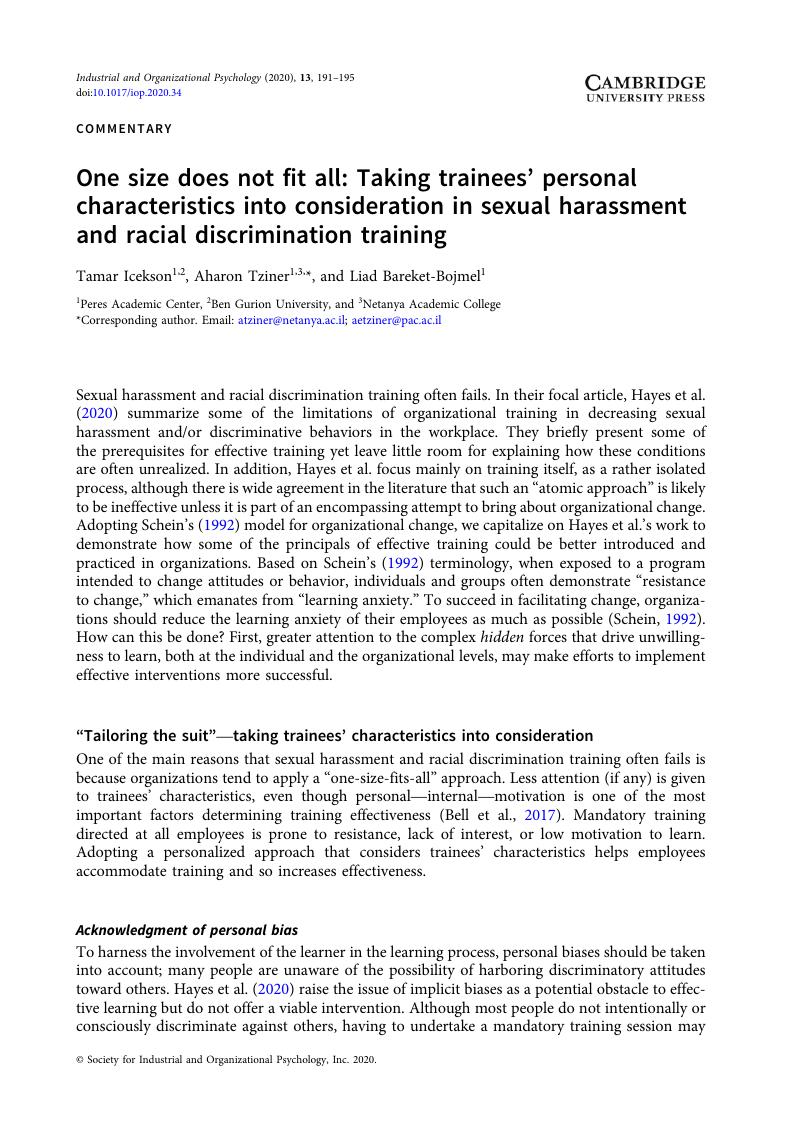No CrossRef data available.
Article contents
One size does not fit all: Taking trainees’ personal characteristics into consideration in sexual harassment and racial discrimination training
Published online by Cambridge University Press: 28 July 2020
Abstract
An abstract is not available for this content so a preview has been provided. Please use the Get access link above for information on how to access this content.

- Type
- Commentaries
- Information
- Copyright
- © Society for Industrial and Organizational Psychology, Inc. 2020
References
Bell, B. S., Tannenbaum, S. I., Ford, J. K., Noe, R. A., & Kraiger, K. (2017). 100 years of training and development research: What we know and where we should go. Journal of Applied Psychology, 102(3), 305–323. https://psycnet.apa.org/doi/10.1037/apl0000142CrossRefGoogle ScholarPubMed
Deci, E. L., & Ryan, R. M. (2002). Overview of self-determination theory: An organismic dialectical perspective. In Deci, E. L., & Ryan, R. M. (Eds.), Handbook of self-determination research (pp. 3–33). Rochester, NY: University of Rochester Press.Google Scholar
Dobbin, F., & Kalev, A. (2015). Why firms need diversity managers and task forces. In Pilati, M., Sheikh, H., Tilly, C., & Sperotti, F. (Eds.), How global migration changes the workforce diversity equation (pp. 170–198). Newcastle, UK: Cambridge Scholars Publishing.Google Scholar
Dobbin, F., & Kalev, A. (2018). Why doesn’t diversity training work? The challenge for industry and academia. Anthropology Now, 10(2), 48–55. https://doi.org/10.1080/19428200.2018.1493182CrossRefGoogle Scholar
Dobbin, F., & Kalev, A. (2019). The promise and peril of sexual harassment programs. Proceedings of the National Academy of Sciences, 116(25), 12255–12260. https://doi.org/10.1073/pnas.1818477116CrossRefGoogle ScholarPubMed
Dweck, C. S. (1999). Self-theories: Their role in motivation, personality and development. Philadelphia, PA: Psychology Press.Google Scholar
Ebert, I. D., Steffens, M. C., Von Stülpnagel, R., & Jelenec, P. (2009). How to like yourself better, or chocolate less: Changing implicit attitudes with one IAT task. Journal of Experimental Social Psychology, 45(5), 1098–1104. https://doi.org/10.1016/j.jesp.2009.06.008CrossRefGoogle Scholar
Emerson, J. (2017, April 28). Don’t give up on unconscious bias training—make it better. Harvard Business Review. https://hbr.org/2017/04/dont-give-up-on-unconscious-bias-training-make-it-betterGoogle Scholar
Evans, M., & Boucher, A. R. (2015). Optimizing the power of choice: Supporting student autonomy to foster motivation and engagement in learning. Mind, Brain, and Education, 9(2), 87–91. https://doi.org/10.1111/mbe.12073CrossRefGoogle Scholar
Grant, A. M., Campbell, E. M., Chen, G., Cottone, K., Lapedis, D., & Lee, K. (2007). Impact and the art of motivation maintenance: The effects of contact with beneficiaries on persistence behavior. Organizational Behavior and Human Decision Processes, 103(1), 53–67. https://psycnet.apa.org/doi/10.1016/j.obhdp.2006.05.004CrossRefGoogle Scholar
Greenwald, A. G., McGhee, D. E., & Schwartz, J. L. K. (1998). Measuring individual differences in implicit cognition: The Implicit Association Test. Journal of Personality and Social Psychology, 74(6), 1464–1480. https://psycnet.apa.org/doi/10.1037/0022-3514.74.6.1464CrossRefGoogle ScholarPubMed
Hahn, A., & Gawronski, B. (2019). Facing one’s implicit biases: From awareness to acknowledgment. Journal of Personality and Social Psychology, 116(5), 769–794. https://psycnet.apa.org/doi/10.1037/pspi0000155CrossRefGoogle ScholarPubMed
Hayes, T. L., Kaylor, L. E., & Oltman, K. A. (2020). Coffee and controversy: How applied psychology can revitalize sexual harassment and racial discrimination training. Industrial and Organizational Psychology: Perspectives on Science and Practice, 13(2), XXX–XXX.CrossRefGoogle Scholar
Hunt, V., Layton, D., & Prince, S. (2015, February 2). Diversity matters. McKinsey & Company. https://assets.mckinsey.com/~/media/857F440109AA4D13A54D9C496D86ED58.ashxGoogle Scholar
Kristanto, A. (2017). The development of instructional materials e-learning based on blended learning. International Education Studies, 10(7), 10–17. https://doi.org/10.5539/ies.v10n7p10CrossRefGoogle Scholar
Madera, J. M., Neal, J. A., & Dawson, M. (2011). A strategy for diversity training: Focusing on empathy in the workplace. Journal of Hospitality & Tourism Research, 35(4), 469–487.CrossRefGoogle Scholar
Martocchio, J. J. (1994). Effects of conceptions of ability on anxiety, self-efficacy, and learning in training. Journal of Applied Psychology, 79(6), 819–825. https://psycnet.apa.org/doi/10.1177/1096348010382240CrossRefGoogle ScholarPubMed
McCann, B. A. (2018). Does workplace sexual harassment training really work? Evolving best practices for EAPs. Journal of Employee Assistance, 48(3), 24–27. http://hdl.handle.net/10713/8146Google Scholar
Quick, J. C., & McFadyen, M. (2017). Sexual harassment: Have we made any progress? Journal of Occupational Health Psychology, 22(3), 286–298. https://psycnet.apa.org/doi/10.1037/ocp0000054CrossRefGoogle ScholarPubMed
Rabelo, V. C., & Cortina, L. M. (2014). Two sides of the same coin: Gender harassment and heterosexist harassment in LGBQ work lives. Law and Human Behavior, 38, 378–391. https://psycnet.apa.org/doi/10.1037/lhb0000087CrossRefGoogle ScholarPubMed
Rattan, A., & Dweck, C. S. (2018). What happens after prejudice is confronted in the workplace? How mindsets affect minorities’ and women’s outlook on future social relations. Journal of Applied Psychology, 103(6), 676–687. https://psycnet.apa.org/doi/10.1037/apl0000287CrossRefGoogle ScholarPubMed
Roehling, M. V., & Huang, J. (2018). Sexual harassment training effectiveness: An interdisciplinary review and call for research. Journal of Organizational Behavior, 39(2), 134–150. https://doi.org/10.1002/job.2257CrossRefGoogle Scholar
Schein, E. (1992). Organizational culture and leadership (2nd ed.). San Francisco, CA: Jossey-Bass.Google Scholar
Stark, N. (2015). Millennials making meanings: Social constructions of sexual harassment regarding gender and power by generation Y (M.A. thesis, University of Central Florida). https://stars.library.ucf.edu/etd/1183/Google Scholar
Tziner, A., Fisher, M., Senior, T., & Weisberg, J. (2007). Effects of trainee characteristics and perceptions on training effectiveness. International Journal of Selection and Assessment, 15, 167–174. https://doi.org/10.1111/j.1468-2389.2007.00378.xCrossRefGoogle Scholar




